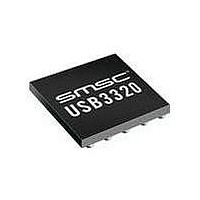USB3300-EZK-TR SMSC, USB3300-EZK-TR Datasheet - Page 44

USB3300-EZK-TR
Manufacturer Part Number
USB3300-EZK-TR
Description
USB Interface IC USB 2.0 PHY ULPI
Manufacturer
SMSC
Type
Hi Speed USB Host Devicer
Datasheet
1.USB3300-EZK.pdf
(55 pages)
Specifications of USB3300-EZK-TR
Maximum Operating Temperature
+ 85 C
Minimum Operating Temperature
- 40 C
Mounting Style
SMD/SMT
Operating Temperature Range
- 40 C to + 85 C
Operating Supply Voltage
3.3 V
Package / Case
QFN-32
Lead Free Status / RoHS Status
Lead free / RoHS Compliant
Available stocks
Company
Part Number
Manufacturer
Quantity
Price
Company:
Part Number:
USB3300-EZK-TR
Manufacturer:
MICRON
Quantity:
3 140
Part Number:
USB3300-EZK-TR
Manufacturer:
MICROCHIP/微芯
Quantity:
20 000
Revision 1.08 (11-07-07)
6.5.2.4
6.5.2.5
6.5.3
6.5.4
APPLICATION
OTG Device
TYPICAL
Vbus Pull-up and Pull-down Resistors
In addition to the internal Vbus comparators the USB3300 also includes the integrated Vbus pull-up
and pull-down resistors used for Vbus Pulsing. To discharge the Vbus voltage, so that a Session
Request can begin, the USB3300 provides a pull-down resistor from Vbus to Ground. This resistor is
controlled by the DischargeVbus bit 3 of the OTG Control register, defined in the ULPI specifications.
The pull-up resistor is connected between Vbus and VDD3.3. This resistor is used to pull Vbus above
2.1 volts so that the A-Device knows that a USB session has been requested. The state of the pull-
up resistor is controlled by the bit 4 ChargeVbus of the OTG Control register, defined in the ULPI
specifications. The Pull-Up and Pull-Down resistor values are detailed in
Vbus Input Impedance
The OTG Supplement requires an A-Device that supports Session request protocol to have an input
impedance less than 100kohm and greater the 40kohm to ground. In addition, if configured as a B-
Device, the PHY cannot draw more then 150uA from Vbus. The USB3300 provides a 75kΩ nominal
resistance to ground which meets the above requirements, see
Driving External Vbus
When a system is operating as a host, it is required to source 5 volts on VBUS. The USB3300 fully
supports VBUS power control using external devices. The USB3300 provides an active high control
signal, CPEN, which is dedicated to controlling the Vbus supply when configured as an A-Device. The
USB3300 also supports external Vbus fault detection detailed in
CPEN is asserted when the ULPI OTG Control register bit 5 DrvVbus or bit 6, DrvVbusExternal is set
high. To be compatible with Link designs that support both internal and external Vbus supplies the
DrvVbus and DrvVbusExternal bits in the OTG Control Register are or’d together. This enables the
Link to set either bit to access the external Vbus enable (CPEN.) This logic is shown in Figure 6.10,
"USB3300 On-the-Go Module". DrvVbus and DrvVbusExternal are set to 0 on POR.
External Vbus Indicator
The USB3300 has fully implemented the External Vbus detection described in the ULPI 1.1
specification. The block diagram of the External Vbus detection is shown in
Table
6.10.
INDICATOR
EXTERNAL
VBUS
USE
0
1
1
1
1
Table 6.10 External Vbus Indicator Logic
PASS THRU
INDICATOR
X
1
1
0
0
DATASHEET
COMPLEMENT
Hi-Speed USB Host, Device or OTG PHY with ULPI Low Pin Interface
INDICATOR
44
X
0
1
0
1
External active high VbusVld signal
External active low VbusVld signal
External active high power fault signal
qualified with internal VbusVld
comparator.
External active low power fault signal
qualified with internal VbusVld
comparator.
Internal VbusVld comparator (Default)
Table
Section
RXCMD VBUS VALID
ENCODING SOURCE
5.6.
(Note
(Note
6.5.4.
Table
6.1)
6.1)
5.6.
Figure 6.10
SMSC USB3300
Datasheet
and in












